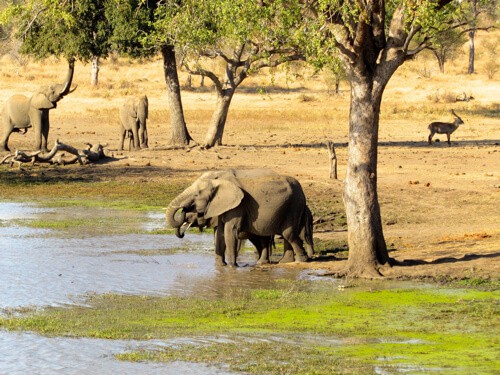Five million years ago, the Ethiopian savanna boasted some three types of giraffe, two rhinos, one hippo, and four elephant-like species. But today’s East African ecosystem appears very different than its ancient counterpart, with communities having fewer very large mammals.
Some scientists have argued that our hominin ancestors—like Homo erectus and their australopithecine relatives—played a role in driving large mammal extinctions in Africa several million years ago. But that explanation for what happened to most of Africa’s ‘megaherbivores’ (a designation for species that weight more than 2,000 pounds) has remained largely untested, until now.
New research shows that there was indeed a steady decline of megaherbivore diversity—all told, 28 major lineages went extinct—that started around 4.6 million years ago. But according to a team including Paul Koch, distinguished professor of Earth and planetary sciences and dean of the Division of Physical and Biological Sciences at UC Santa Cruz, the demise of these large mammals was mainly due to grassland expansion on the continent that was likely tied to falling atmospheric carbon dioxide levels.
“The extinction of these megaherbivores took place over the course of nearly 4.5 million years, and pre-dated major events in pre-human cultural development like butchering animal carcasses with stone tools by some one million years,” he said.
Koch joined a team led by Tyler Faith, assistant professor of anthropology at the University of Utah and curator of archaeology at the Natural History Museum of Utah, to “rigorously test the idea” that our human ancestors affected significant changes in the surrounding ecosystem. Faith said such speculation is not unreasonable as, “We know that our species is more than capable of driving extinctions today, so why not extend the history of our impacts on the natural world deep into our evolutionary past?” But in this case, the data didn’t support that theory.
In this new study—published November 23 in the journal Science—Koch, Faith, and their colleagues John Rowan from the University of Massachusetts Amherst and Andrew Du from the University of Chicago, compiled a seven-million-year record of megaherbivore extinctions from more than 100 fossil sites in eastern Africa. The team noted that, not only did the extinctions begin long before the emergence of any hominin species that might even be remotely capable of hunting, but the rate of megaherbivore diversity decline didn’t change following the appearance of Homo erectus, one of the human ancestors previously associated with the extinctions. Instead, study of stable carbon isotope records of vegetation from east Africa and global atmospheric carbon dioxide records revealed a link between extinction and the spread of grassland and falling atmospheric carbon dioxide over the last five million years.
“Tropical grasses do better under low carbon dioxide levels; their type of photosynthesis gives them a competitive edge against other plants,” Koch said. “So the grasses expanded, and the trees receded.” And since the isotopic data indicated that many of the extinct megaherbivores ate woody vegetation, the group proposed that these animals disappeared along with their food.
This isn’t the first time Koch has used isotope chemistry data to track changes in species and their habitats over time. In 2012, he worked with Ph.D. student Brooke Crowley and others to study how ecology shaped the extinction of giant lemurs after humans arrived on Madagascar.
“Human impacts are extremely important in explaining what’s happened to the world over the 100,000 years,” Koch said. “You can see the human thumbprint everywhere, but it’s important to explore whether other explanations are equally viable.”
For Koch, the value of this study isn’t necessarily about debunking old theories about anthropogenic impacts. For him, it’s an elegant example of how environmental changes drive floral changes, which then drive faunal changes.
“The modern faunas of Africa are iconic examples of how communities with large mammals work,” he said. “Now we see how grassland expansion shaped those communities—in the very same ecosystem that drove our own evolution as a species.”

